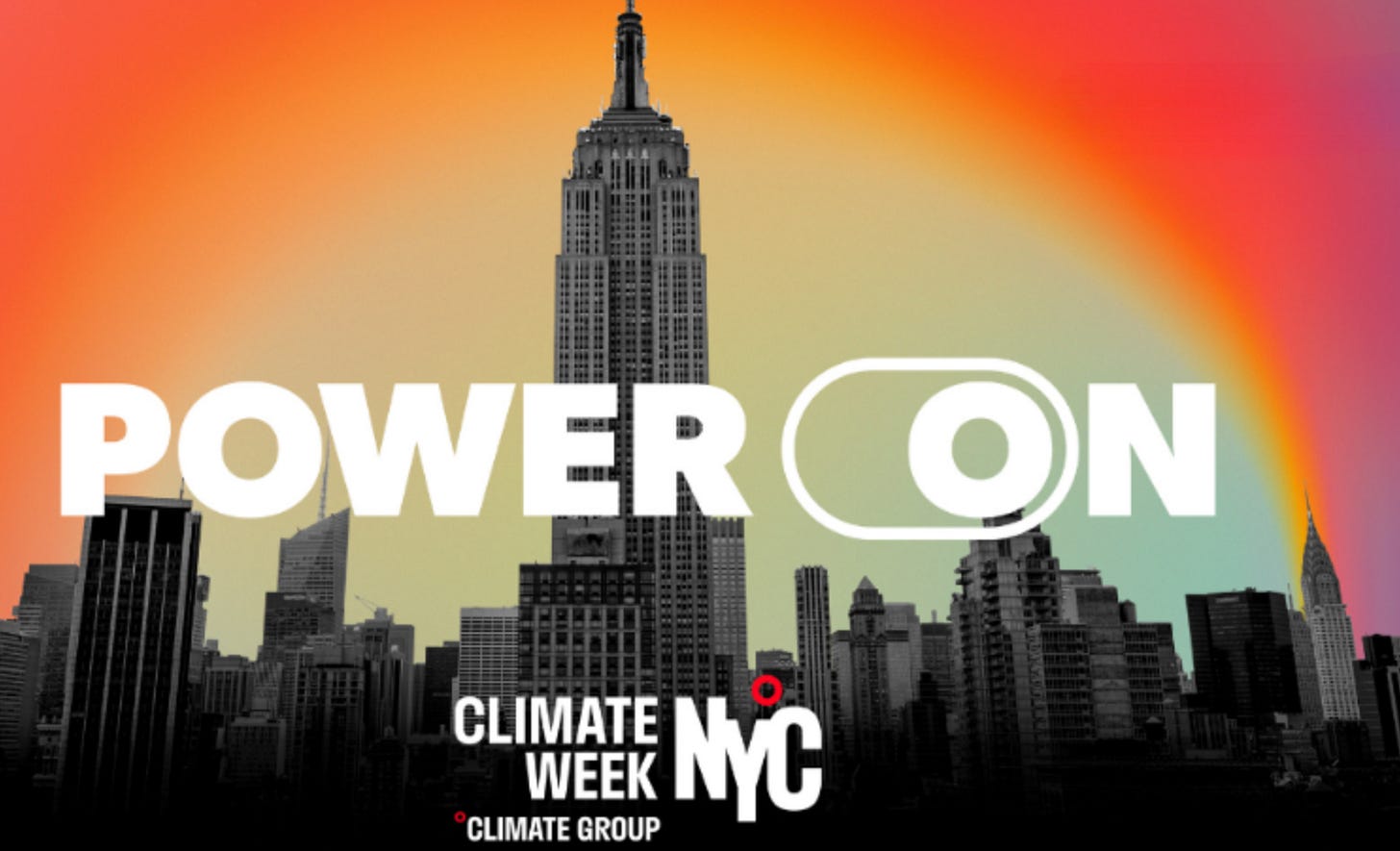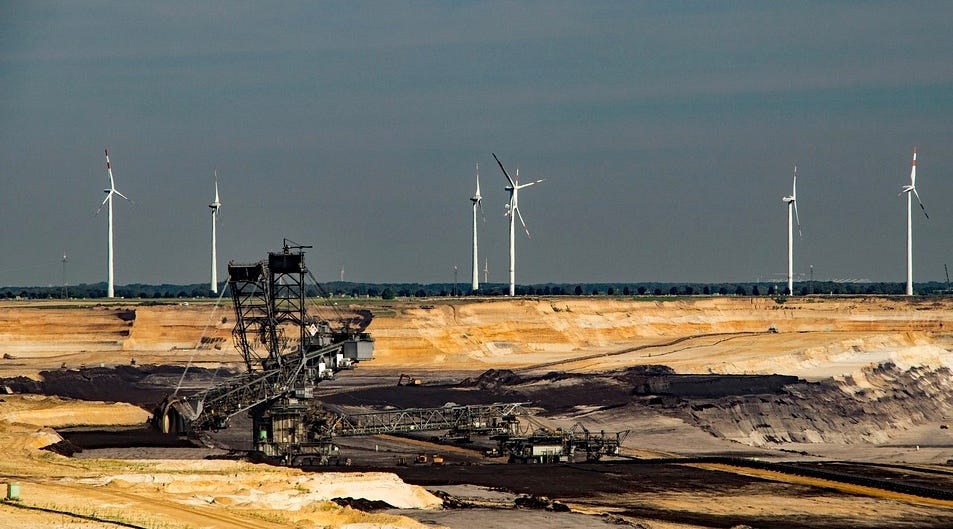Green energy advocates take stock ahead of NYC Climate Week
Welcome to Callaway Climate Insights, your daily guide to global climate finance. Was this shared with you? Please enjoy and subscribe.
Today’s edition of Callaway Climate Insights is free for all our readers. We really want to bring you the best and latest in climate finance from around the world. Please subscribe now.
Next week marks the 16th New York Climate Week, and while the hostility toward green energy from the White House caused the spirit of the event to largely shift to London Climate Week this year, investors, advocates and protesters will be out in force in the Big Apple as it’s also the annual meeting of the United Nations General Assembly.
In the absence of any real progress on mitigating global warming this year, much of the media and climate world has focused on taking stock, if you will, on where we are a decade after the Paris Agreement lit the fires of the environmental, social and governance movement. A classic example being this rambling timeline from the New York Times.
It doesn’t take 10,000 words of backdrop to tell climate advocates that things look dark during the Trump administration. With President Donald Trump himself coming to New York to speak at the UN next week, we’re sure to hear his own unique take on how oil, gas and new forms of nuclear energy will help establish a new order (more on that below). But renewable energy executives and investors will be meeting anyway on the sidelines of the UN to discuss strategies and new technologies.
Those searching for optimism will find plenty in the form of how well other countries, including China, are coming along in developing green power, including electric vehicles. And on how U.S. companies are preparing to stick this era out and continue developing their business plans despite the hostility from Washington.
Also, Scientific American made an effort to point out that 40 years after scientists discovered a growing hole in the ozone layer, imperiling humanity, global efforts to reduce it continue to succeed. So, there’s that, but that coming together seems a long way off now.
In past years, the climate world came to New York energized and left feeling even more so. That’s not guaranteed this year. But just the fact that leaders and investors will be coming to New York to support each other, and the city itself for that matter, is a testament to the resilience of a movement that will long outlast the current administration.
Don’t forget to contact me directly if you have suggestions or ideas at dcallaway@callawayclimateinsights.com.
Follow us . . . .
Twitter | LinkedIn | Facebook | Instagram
The elusive shareholder democracy in new proxy voting programs
. . . . Mutual fund giants report a surge in investors participating in new proxy voting programs, with Vanguard, BlackRock, and State Street all claiming higher numbers of investors eligible to take part this year, writes Mark Hulbert. At the same time, the number of shareholders voting ESG-specific proxies plunged, at Vanguard by about half. Hulbert tries to make sense of the disconnect and finds that it’s a combination of a confusing voting process steps and the sheer legal bulk of these types of policies, which in Vanguard’s case is more than 100 pages long. The result is a dilution of shareholder democracy at every step, followed by the inevitable disillusionment.
Thursday’s subscriber insights
Exporting the small nuclear reactor dream
. . . . President Donald Trump arrived in the UK this week to be greeted with as many as five deals worth what his team said could be $100 billion to build small nuclear reactors in partnership with U.S. and British businesses.
No surprise on the deals. It’s common practice for the advance teams of global leaders to line up softball deals for their trips so they can show the folks back home they’re doing more than attending state dinners. What is new is that now the U.S. is exporting the longshot dream of small module nuclear reactors (SMRs) to a willing Labour government in London under the name of shared energy security.
The deals, which involve some of the UK’s biggest energy companies, came with the political promise of a ‘golden age’ in nuclear energy, whatever that is.
The UK is littered with failed or unfulfilled nuclear deals and throwing SMRs into the mix won’t help. To date, none have been built anywhere. Nobody is providing any sort of legitimate plan for what to do with the waste, or what happens when the golden age of nuclear energy lands in your neighborhood.
There is definitely a future in nuclear energy. And as it’s a renewable energy the Trump team is on board with, it makes sense that UK Prime Minister Keir Starmer would offer something like this to avoid controversy during what could be an extremely controversial visit.
But investors should take the new business with a grain of salt. These deals tend to last about as long as the geopolitical headlines that describe them.
Callaway Climate Insights joins The Independent for NYC Climate Week
. . . . Callaway Climate Insights is joining The Independent in New York City next week to honor The Independent’s annual Climate 100 list of entrepreneurs, political leaders, green advocates, and celebrities making a difference in helping the world transition to renewable, sustainable energy.
The event will be held on Tuesday, Sept. 23 at The Independent’s New York bureau in midtown and feature Octopus Energy Founder and CEO Greg Jackson, speaking with Independent Editor-in-Chief Geordie Greig. It also will feature a Q&A with David Callaway and Independent World Affairs Editor Sam Kiley, who just returned from a climate reporting trip to Africa.
For more information and details on the Climate 100 and related events, click here.
Editor’s picks: Signs of ancient life on Mars; plus, time’s up for tax credits
Watch the video: NASA’s Mars rover Perseverance has uncovered rocks in a dry river channel that may hold potential signs of ancient microscopic life. The rover has found what NASA calls “textural features.” It’s unknown what they are, but NASA says they are potentially made by some sort of ancient life form. While not life itself, these may be “a signature.”
12 days to get that EV, rooftop solar or heat pump
Just a reminder that tax credits for EVs, rooftop solar, heat pumps, energy-efficient windows, and more end on Sept. 30. Tax credits for EVs were originally set to last until 2032, but the July budget passed by Congressional Republicans ended them ahead of schedule. The One Big Beautiful Bill also set an end date of Dec. 31, 2025, for electric home appliances, energy efficiency improvements, and more, Samantha Harrington writes for Yale Climate Connections. The exception is a tax credit for EV chargers, which will remain available through June 30, 2026. For all the information on energy efficient home improvement credits and residential clean energy credits, check out this tax credit site from the IRS.
Latest findings: New research, studies and projects
Insurers' carbon underwriting policies
The authors of this finance working paper of the European Corporate Governance Institute study the determinants, structure, implementation, and effects of carbon underwriting policies among the world’s largest insurers. From the abstract: “Adoption is more common among European insurers and less so among specialty and unlisted firms, with coal policies preceding those for oil and gas. Using novel mine-insurance data, we show that implementation is often incomplete, and some insurers expand coal coverage despite commitments. On average, insurers reduce the number of insured mines by 16%, insured coal volumes by 56%, and make continued coverage 13pp less likely. Affected mines are more likely to be abandoned and experience constrained operations.” Authors: Olimpia Carradori, University of Zurich - Department of Finance, Swiss Finance Institute; Felix von Meyerinck, Lake Lucerne Institute; University of Zurich - Department of Finance; Zacharias Sautner, University of Zurich - Department of Finance; Swiss Finance Institute, European Corporate Governance Institute.
More of the latest research:
Words to live by . . . .
“Time is running out. Our window of opportunity is narrow. I believe there are true limits to the resources of our planet, but there is no limit to the human imagination and our capacity to solve the biggest challenges of our time." — Robert Redford.







